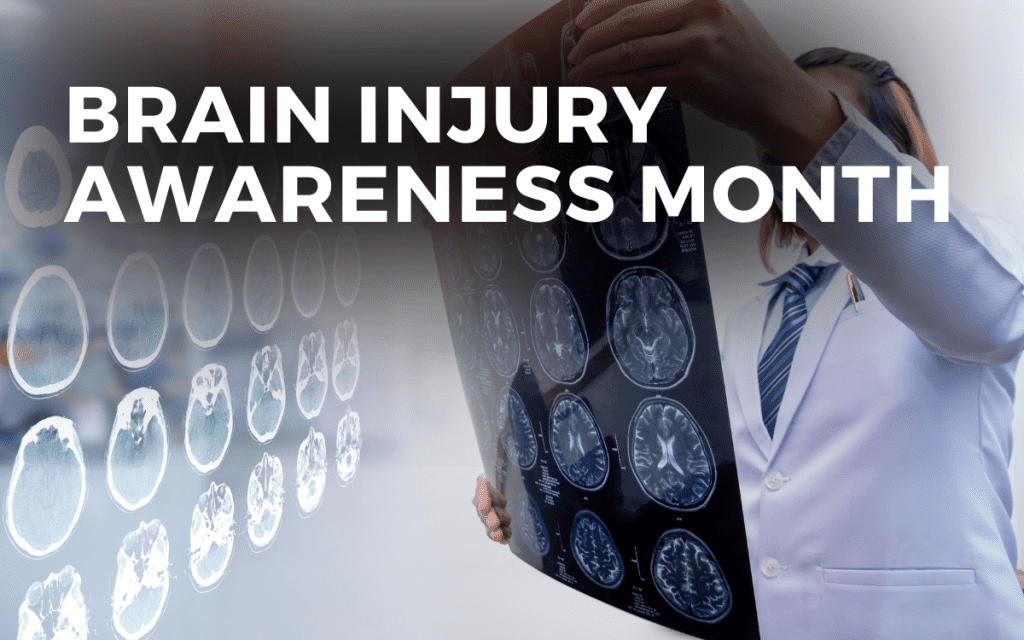Brain Injury Awareness Month is an important time to recognize the impact that brain injuries have on individuals and their families. It’s a chance for us all to take action, spread awareness, and show our support. Brain injury can affect anyone at any age – from young children who are still growing up to adults with long-term health conditions.
Brain Injury Awareness Month is held in March. In this article, we’ll explore some of the common causes of brain injuries, look at symptoms you should watch out for, discuss how best to prevent them in the future, as well as highlighting other resources available so that you can get involved too! So let’s dive into what Brain Injury Awareness Month is all about!

What is Brain Injury Awareness Month?
Brain Injury Awareness Month is an annual celebration held during the month of March. It was created to increase public knowledge about traumatic brain injury (TBI), which can be caused by car accidents, falls, sports-related activities, or any other type of accident that results in a blow or jolt to the head. TBI can lead to long-term physical and cognitive impairments such as difficulty with speech or movement, memory loss, headaches, dizziness, fatigue, and more.
When is Brain Injury Awareness Month?
Brain Injury Awareness Month is observed in March each year in the United States. The month-long observance provides an opportunity for individuals, organizations, and communities to come together to promote education and support for people living with a disability due to a brain injury.
History of Brain Injury Awareness Month
Brain Injury Awareness was first observed in 1996 by the Brain Injury Association of America (BIAA) as a way to educate people on how to prevent brain injuries and support those who have been affected by them.
How to Celebrate Brain Injury Awareness Month
During Brain Injury Awareness Month, there are many ways for small business owners and entrepreneurs to show their support for this important cause. A few ideas include:
- Host events such as fundraisers or educational seminars at your business location
- Create social media campaigns featuring facts about TBI
- Offer discounts on products related to brain health
- Donate proceeds from sales during the month
- Sponsor local community events focused on raising awareness about TBI
- Partner with organizations dedicated to helping those affected by TBIs
- Volunteer time at hospitals providing care for patients suffering from these types of injuries
- Share posts online, encouraging others to learn more about this issue.
Hashtags for Brain Injury Awareness Month
When sharing social media posts about Brain Injury Awareness Month, make sure you use relevant hashtags so more people can see them. Popular hashtags include:
- #braininjuryawarenessmonth
- #biam
- #morethanmybraininjury
- #braininjury
- #tbi
- #braininjuryawareness
- #traumaticbraininjury
- #braininjurysurvivor
- #brainhealth
- #headinjury
- #tbisurvivor
- #tbiawareness
For the complete list of holidays to celebrate on social media in March, visit angiegensler.com/march-holidays
How Can You Show Support During Brain Injury Awareness Month?
One way you can show your support during Brain Injury Awareness Month is through donations. Organizations like The Brain Injury Association of America provide resources for those affected by brain injuries, including information about treatment options and access to financial assistance programs. Donating money or other resources helps these organizations continue their work and make a difference in people’s lives.
Sharing information on social media is another great way to raise awareness about the importance of preventing brain injuries during this month-long observance. You can share facts about common causes and symptoms associated with brain injuries as well as tips on how to prevent them from occurring in the first place. Be sure to use relevant hashtags such as #BrainInjuryAwarenessMonth or #BIAM when posting so others can find your content easily!
Hosting an event in your community is also a great way to spread awareness about Brain Injury Awareness Month while raising funds for local organizations that provide services related to traumatic brain injury (TBI). Consider organizing a walkathon or hosting an educational seminar where experts discuss topics like prevention strategies, treatment options, and available resources for those living with TBIs—all while collecting donations at the same time!
Finally, if you know someone who has been personally impacted by a traumatic brain injury, take some time out this month to reach out and offer your support however you can. This could be simply lending an ear or providing practical help around their home or workplace – it all makes a difference.
By showing support during Brain Injury Awareness Month, you can help spread awareness and understanding of the causes, effects, and prevention of brain injuries. Let’s take a look at some common causes of these injuries in the next section.
Where Can I Find More Information About Brain Injury Awareness Month?
For more information about Brain Injury Awareness Month you can visit websites such as www.biausa.org which provides resources for those affected by TBIs as well as information about prevention strategies and treatment options available for those with TBIs. Additionally, they have educational materials such as brochures, posters, videos, webinars etc., that are designed to help raise awareness around brain injury topics.
You can also find helpful information from organizations like the Centers for Disease Control and Prevention (CDC), National Institute of Neurological Disorders and Stroke (NINDS), American Speech-Language Hearing Association (ASHA) and National Institutes of Health’s Traumatic Brain Injury Information Page (NIH/TBIIP). These organizations provide valuable research studies related to traumatic brain injuries along with other useful resources on their websites.
FAQs in Relation to Brain Injury Awareness Month
What is brain injury awareness day?
Brain Injury Awareness Day is an annual event held on the first Wednesday of March to raise awareness about traumatic brain injuries (TBI). It was established in 1996 by the Brain Injury Association of America and has since been adopted by other organizations around the world. The day serves as a reminder that TBI can happen to anyone, anytime, anywhere and encourages people to take steps towards prevention. It also provides an opportunity for those living with TBIs to share their stories and advocate for better care and support services.
What color is the ribbon for traumatic brain injury?
The ribbon for traumatic brain injury is teal. Teal is a light blue-green color that symbolizes the healing process and hope associated with those who have suffered from this type of injury. It also represents the courage and strength of those affected by TBI, as well as their families and friends. The awareness ribbon serves to remind people of the importance of supporting research into treatments for TBI and providing support to those living with it.
What are 3 types of brain injuries?
1. Traumatic Brain Injury (TBI): This type of brain injury is caused by a sudden trauma to the head, such as a car accident or fall. It can cause physical damage to the brain tissue and can result in long-term complications including memory loss, difficulty concentrating, impaired speech and language skills, personality changes, and depression.
2. Acquired Brain Injury (ABI): ABI occurs when an illness or disease affects the functioning of the brain. Examples include stroke, meningitis, encephalitis and tumors. Symptoms vary depending on which part of the brain is affected but may include seizures, confusion or disorientation, difficulty with communication and problem solving skills.
3. Anoxic Brain Injury: Anoxic brain injuries occur when there is a lack of oxygen reaching the brain due to drowning or choking for example; this deprives cells in the brain from receiving essential nutrients needed for proper functioning resulting in cognitive impairments such as memory loss and poor concentration levels.
Who Does Brain Injury Awareness Month Affect?
Brain Injury Awareness Month affects a wide range of people, from those who have suffered from traumatic brain injuries (TBIs) to their families and friends. It also affects medical professionals, researchers, and advocates who are working to improve the lives of those affected by brain injuries.
Those with TBIs may suffer from physical impairments such as paralysis or loss of motor control; cognitive deficits such as memory loss or difficulty concentrating; behavioral changes such as aggression or depression; and emotional issues like anxiety or mood swings. The effects can be long-lasting and life-altering for both the person suffering from the injury and their loved ones.
Families often struggle to adjust to the new normal after a family member has suffered a TBI. They must learn how to provide care for their loved one while managing other aspects of life, including work, school, financial responsibilities, etc., all while dealing with their own emotions related to this difficult situation.
Medical professionals play an important role in providing care for those with TBIs through diagnosis, treatment plans that include medication management and therapy services, rehabilitation programs designed specifically for each individual’s needs, education about how best to manage symptoms at home on an ongoing basis – and more importantly – emotional support during what can be a very challenging time in someone’s life.
Researchers are constantly looking into ways they can better understand brain injuries so they can develop more effective treatments that will help individuals recover faster and live healthier lives post-injury. Advocates work hard every day advocating for policy change that will benefit individuals living with TBIs—from improved access to healthcare services to increased funding for research initiatives focused on finding cures/treatments/prevention methods related to these types of injuries.
Brain Injury Awareness Month is an important reminder that we should all take steps toward understanding these types of injuries better. Then we can do our part in helping those affected lead happier lives despite any challenges they may face due to TBIs.
Brain Injury Awareness Month affects everyone, from those living with a brain injury to their families and friends. Showing support during this month can make a huge difference in raising awareness and helping people affected by brain injuries. Let’s take a look at how you can show your support during Brain Injury Awareness Month.
What Are Some Common Causes of Brain Injuries?
Brain injuries can be caused by a variety of factors, ranging from physical trauma to medical conditions. Traumatic brain injuries (TBIs) are usually the result of an external force, such as a blow or jolt to the head. Falls, motor vehicle accidents, sports-related activities, physical assaults, and blasts from explosions are some of the most common causes of TBIs.
In addition to traumatic brain injuries, there are other types of brain injury that may not involve direct contact with an external force. Stroke is one example; it occurs when blood flow to part of the brain is blocked or reduced due to a clot or other blockage in an artery leading to the brain. Brain tumors can also cause damage by putting pressure on surrounding tissue and interfering with normal functioning. Infections such as meningitis and encephalitis can also lead to serious neurological problems if left untreated for too long.
Exposure to toxic substances like lead or carbon monoxide poisoning can also cause damage over time if levels remain high enough for long periods without proper ventilation and safety precautions being taken. In these cases, symptoms may not appear until much later after exposure has occurred, which makes prevention all the more important in order to reduce risk factors associated with these types of exposures.
No matter what type of injury you’re dealing with—whether it’s traumatic or non-traumatic—it is important that you seek medical attention right away. This will allow your doctor to diagnose any potential issues quickly and accurately before they become worse over time. Early diagnosis is key when it comes to treating any kind of neurological condition, as treatment options tend to be more effective when caught early on in its progression rather than waiting until symptoms have worsened significantly before seeking help from professionals who specialize in this field.
Common causes of brain injuries include falls, motor vehicle accidents, sports-related incidents, and physical violence. It is important to be aware of the symptoms associated with a brain injury in order to take appropriate action. Let’s explore these further in the next section.
What Are The Symptoms Of A Brain Injury?
Brain injuries can be serious and life-altering, so it’s important to understand the symptoms of a brain injury. Depending on the severity and location of the injury, symptoms may vary, but some common signs include:
Headaches: A headache is one of the most common signs of a traumatic brain injury. The pain can range from mild to severe and may last for days or weeks after an accident.
Confusion: After sustaining a head injury, confusion is often present due to cognitive impairment caused by damage to parts of the brain responsible for memory and thinking skills. This symptom should not be ignored as it could indicate more serious issues, such as bleeding in or around the brain.
Memory Loss: Memory loss is another sign that something isn’t right following a head trauma. It’s possible for someone with a TBI to experience short-term memory loss where they are unable to recall recent events or conversations that took place before their accident occurred. Long-term memory loss can also occur if there has been significant damage done to certain areas in the brain responsible for storing memories over time.
Difficulty Concentrating: Difficulty concentrating is another symptom associated with traumatic brain injuries because it affects how well someone can focus on tasks at hand or retain the information being presented during lectures or meetings at work/school etc. This difficulty in concentration could lead to problems completing assignments, taking tests, understanding instructions given by teachers/bosses, etc., which could ultimately affect job performance and academic success if left untreated.
Dizziness and blurred vision are two other common symptoms associated with TBIs due to disruptions in blood flow throughout different parts of your body, including your eyesight, which can cause blurry vision when looking at objects up close or far away. Additionally, dizziness occurs when balance centers located within the inner ear become damaged, leading to a feeling of being off-balance even while standing still without any movement involved.
Ringing in the ears and sleep disturbances such as insomnia are commonly experienced after suffering from a traumatic brain injury. This is because these types of injuries cause disruption within various systems throughout our bodies, including those related directly to auditory functions like hearing sounds correct and regulating sleeping patterns properly so that we don’t feel overly tired during daytime hours or overly awake during nighttime hours.
Fatigue is another symptom associated with TBIs, as this type of injury affects energy levels within our bodies, causing us to feel exhausted even after getting enough restful sleep each night, making everyday activities seem much harder than usual. Additionally, seizures may occur if there has been significant damage done inside certain areas within our brains responsible for controlling electrical activity, which then leads to experiencing involuntary muscle contractions resulting in convulsions medically known as “seizures.”
It is important to recognize the symptoms of a brain injury, as they can vary greatly depending on the severity. Knowing how to prevent brain injuries is also essential in order to keep yourself and your loved ones safe.
How Can You Prevent Brain Injuries?
The best way to prevent a traumatic brain injury is to practice safe behaviors. Wearing a helmet when riding a bike or motorcycle and using seatbelts when driving or riding in a car are two of the most important safety measures you can take. Additionally, it’s important to be aware of potential hazards in your home, such as slippery floors or loose rugs that could cause someone to trip and fall, which could result in a head injury.
It’s also important for parents and caregivers of young children to be aware of potential dangers around the house, such as sharp edges on furniture, stairs without railings, and any other items that may pose an unnecessary risk. Children should always wear helmets while playing sports like skateboarding, skiing, snowboarding, etc., as well as protective gear during contact sports like football or hockey.
In addition to taking preventive measures at home and outdoors, it’s essential for people who work with heavy machinery or hazardous materials (such as construction workers) to use proper safety equipment, including hard hats, whenever possible. It’s also important for employers to provide their employees with adequate training so they understand how dangerous certain tasks can be if not done properly.
Finally, avoiding activities that involve excessive drinking or drug use is another key factor in preventing brain injuries since these substances can impair judgment and increase the likelihood of accidents occurring due to risky behavior. If you do choose to drink alcohol, make sure you do so responsibly by never getting behind the wheel after consuming alcohol and having someone else drive instead if necessary.
By following these simple tips, everyone can help reduce their chances of suffering from a traumatic brain injury due to an accident or other incident caused by negligence or carelessness on their part. Taking preventive measures at home and outdoors, using proper safety equipment in hazardous work environments, avoiding activities that involve excessive drinking or drug use, and practicing responsible behavior when consuming alcohol are all key factors in preventing brain injuries.
By taking the necessary precautions and educating yourself on brain injury prevention, you can help to reduce the number of traumatic brain injuries. To learn more about Brain Injury Awareness Month, read our next heading: “Where Can I Find More Information About Brain Injury Awareness Month?”
Conclusion
We hope that this blog post has provided you with some useful information about Brain Injury Awareness Month so that you can spread awareness in your own community and support those who have been impacted by this condition.
During Brain Injury Awareness Month, let’s use our voices on social media to spread knowledge about the causes and effects of traumatic brain injury (TBI). We can also share stories from survivors who have found success in their recovery journeys. Let’s work towards finding solutions for those affected by TBI so they may lead fulfilling lives. Join us in this effort today!















